With most brands going with desk designs that don’t include traditional cross supports, it was refreshing to see Uplift wanting to create something more stable. As soon as the Uplift v2 Commercial was released, we began to receive calls about how it compared to our VertDesk v3.
Today, we take a closer look at the Uplift v2 Commercial and the VertDesk v3. We will look at how they compare with their stability, internal components and other build quality aspects to see which is best for your standing desk needs.
Full Disclaimer: We are an office furniture dealer and sell some of the products we review. To learn more about the products we sell, our review process and why you can trust us, please visit: Why we’re different. Who is BTOD.com and The Breakroom Blog?
Uplift v2 Commercial vs. VertDesk v3 Links
– OEM Manufacturer
– Where Are Components Made?
– Pricing
– Assembly
– Specs / Features
– Stability
– Technology
– Electronics
– Weight Capacity Testing
– Motors / Gears / Glides
– Frame and Foot
– Additional Options
– Return Policy and Warranty
OEM Manufacturer
Uplift Desk is manufactured by Jiecang Linear Technology, based out of China, and established in 2000 as a home care and medical furniture manufacturer. In 2011, they realized an opportunity for adding their linear actuator technology into frames to create electric standing desks. Today, they are considered a leading Chinese manufacturer of standing desks.
The VertDesk v3 is manufactured by K&A Mfg. Inc., makers of RA Products and the standing desk brand, NewHeights. Based out of Schofield, WI, they were established in 1985 as an ergonomic accessory company. K&A Mfg. has evolved to include a full line of office furniture. They also provide OEM manufacturing for many large organizations and government agencies in the USA. K&A has been involved in the production of electric standing desks for over 15 years.
Where are the components made?
| VertDesk v3 | Uplift v2 Commercial | |
| Frame | Taiwan | China |
| Electronics | Hungary | China |
| Gears | Germany | China |
| Assembly | USA | China |
Pricing and Lead Time
Current pricing and availability is a common question for customers. We found that laminate options from both brands are close in price, depending on the current offers available. The base-only option for the Uplift v2 is expandable and only has one price. The VertDesk v3 includes a fixed cross support and a fixed upper frame component. These additional items will increase the price of the frame as the size increases.
| Most Popular Sizes | VertDesk v3 | Uplift Desk v2 Commercial |
| Base (no top) | $735.99 | $549.00 |
| 30” x 60” Laminate | $919.99 | $839.00 |
| 30” x 60” Bamboo | n/a | $909.00 |
| 30” x 60” Solid Wood | $1,753.99 | $1,039.00 |
| Average Lead Time | 5 Business Days | 1-2 Business Days |
Assembly
Each desk requires about 30 to 90 minutes, depending on your skill level. It is recommended to have a second person to help assemble and flip the desk over when completed.
The Uplift Commercial v2 comes without the feet and work surface supports attached. The pain point for the Uplift base is connecting the feet; the allen wrench included in the box isn’t long enough for good leverage. We recommend using your own so that the feet are fully tightened. Also, consider adding Loctite Threadlocker for a more consistent hold on the foot assembly, cross support and upper support.
The VertDesk v3 has the feet and upper supports welded to the columns. The VertDesk v3 pain point is inserting the hex rod into the leg opposite the motor. If the gear inside the column isn’t perfectly aligned, you may need to use a wrench to turn the hex rod 1/12 to slide it into the column.
Standard Specs/Features
| Features | VertDesk v3 | Uplift v2 Commercial |
| Button Options | Standard up/down push button | Standard up/down push button |
| Lifting Capacity | 275lbs | 355lbs |
| Motor(s) | Single | Dual |
| Adjustment Range | 27” to 47.5” | 22.6” to 48.7” |
| Adjustment Speed | 1.55” per second | 1.35” per second |
| Soft Start – Stop | Yes | Yes |
| Auto-dark LED display | Yes | Yes |
| Leveling Glides | .5” adjustment | .375” adjustment |
| Expandable Frame | n/a | 42.25” to 70” Wide |
| Anti-collision | Yes | Yes |
| Overload Protection | Yes | Yes |
| Frame Material | Steel | Steel |
| Foot Material | Steel | Steel |
Stability of Each Desk
One of the most common questions with all standing desks is how stable they are. Do a search for any standing desk brand and you will see that Google recommended searches now include “brand + wobble”. Two distinct motions affect full standing desks; front to back motion and/or a left to right wobble.
WobbleMeter Testing Uplift Commercial vs VertDesk v3
If you would like to see the pictures and videos of us testing the VertDesk and Uplift on the WobbleMeter, please visit the page for each brand (VertDesk v3 WobbleMeter and Uplift v2 Commercial WobbleMeter). Below is the deflection score range guide for the WobbleMeter. How these results impact your experience will depend on your sensitivity to wobble and rocking motions.
If you’d like to learn more about using the WobbleMeter visit: what is the WobbleMeter?
WobbleMeter Score Range Guide

0-20 = Excellent Stability
Almost all of the desks tested at sitting height will score between 0-20. This is our baseline for excellent stability since most standing desks provide excellent stability at their lowest heights. Users in this range will not notice motion.
21-30 = Very Good to Good Stability
Between 20-30, most users will not notice the small amount of motion in this range.
31-40 = Good to Fair Stability
Between 31-40, some users may begin to notice the amount of motion in this range. This is especially true the closer the score is to 40.
41-50 = Fair to Bad Stability
Between 41-50, most users will notice the amount of motion in this range. This is especially true the closer the score is to 50.
51-60+ = Very Bad Stability
Between 51-60+ all users will notice the amount of motion in this range. This is especially true for scores that are above 60.
WobbleMeter Results for the VertDesk v3 Frame
Overall Wobble (Side to Side) Deflection Scores



Overall Rocking (Front to Back) Deflection Scores

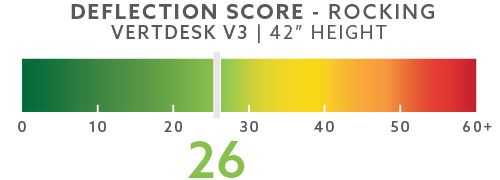
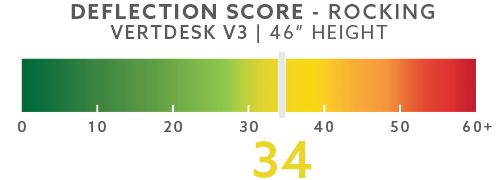
WobbleMeter Results for the Uplift v2 Commercial Frame
Overall Wobble (Side to Side) Deflection Scores
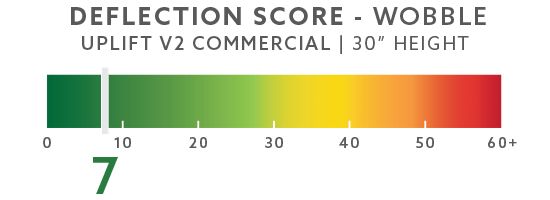

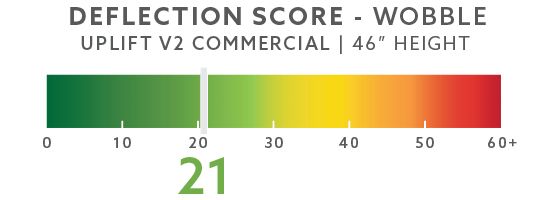
Overall Rocking (Front to Back) Deflection Scores

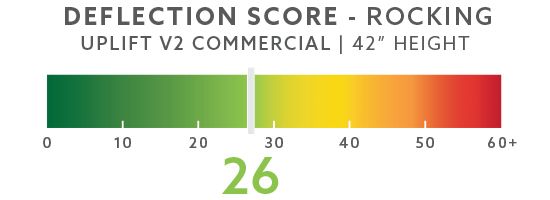

Technology Comparison
Both the Uplift Commercial v2 and VertDesk v3 feature a smart control box system. Each brand offers a standard two-button, up and down button. They also offer an option four position memory switch as an upgrade.
Both desks have options to add Bluetooth to each control box. The Uplift Commercial V2 uses a separate dongle system that plugs into the control box, while the VertDesk v3 uses a Bluetooth controller that is built-in to the control box. Both will allow you to connect to your desk from your cell phone with free apps. These apps will enable you to connect to your desk to move each up and down.
A very unique feature on the VertDesk v3 is the optional voice control element that is part of its app. This is the first functional voice control system that allows for hands-free adjustments with your desk. You can program four preset positions that can be activated by asking Siri to complete the command.
Both desks feature collision avoidance systems that are more sensitive than the standard software driven alternatives. Uplift v2 Commercial users a 6-way accelerometer inside the control box. The VertDesk v3 uses a similar system with a Gyrosensor inside the control box. Both are very good at understanding when there is a soft collision and reversing the direction of the desk to reduce the risk of potential damage or injury.
Something new that we found on the Uplift v2 Commercial was the introduction of an overload function. When too much weight is added to the desk, it will error out and you will need to perform a reset. This feature is included in the VertDest v3 as well. I like this as it helps to prevent user error that could end up being costly if you were to add too much weight.
Circuit Board Comparison
Like I have done with all desks that have come through the testing lab, I like to open up the control box and see what the manufacturer is hiding. Knowing that JieCang has added some additional functionality to the Uplift v2 Commercial, I had expected to see a different circuit board than previous products we’ve reviewed, including the standard v2 from Uplift.
After opening the control box, it was a bit disappointing to see there was almost nothing different from the standard v2. A nearly identical two-board system is used for the Commercial v2, with the most significant change being linked to the software. The same low-quality power supply is being used, with excessive amounts of silicone caulk to hold these components in place. Not the ideal situation for a product that has a lot of vibrations from daily movement.

This isn’t surprising, as the only brand we’ve found coming from China, to use a single board system designed for use with this product, are on the Kaidi. This is the OEM that makes the VARIDESK ProDesk Electric product. Because a two-board system is used, JieCang connects the board with poorly connected plastic clips.
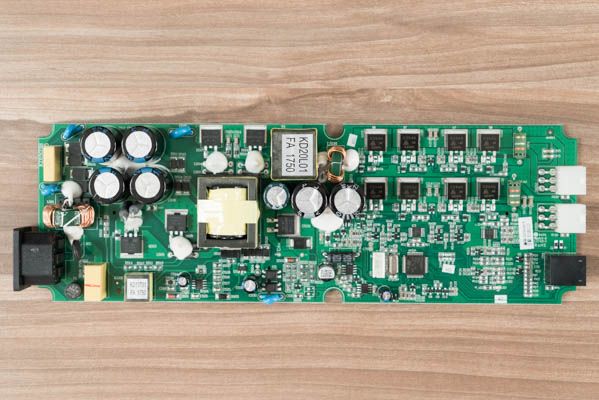
The VertDesk v3 features a single board control box system, engineered and manufactured by Laing Innotech, specifically for use in an electric standing desk. A four-layer circuit board is used to maximize functionality and create the smallest footprint possible. The components on the VertDesk’s circuit board are securely fastened with solid platforms and permanent soldered connections.

The only true weakness we found with the VertDesk v3’s control box is the way the toroid core had been wrapped. Having previously used LogicData, this component was perfectly wrapped with no overlap issues. The current core has some overlap and this could be improved.

Weight Capacities and Testing
The Uplift Desks dual-motor system boasts a large, 355 lbs. lifting capacity. We were able to test the frame with the max load and the motors were strong enough to lift the weight. We found the average speed for the frame to be approximately 1.35”/second after ten cycles. When overloaded to 400 lbs., the desk was overloaded and presented an error as overload protection was triggered.
The VertDesk v3 single motor system offers a more conservative 275 lbs. lifting capacity. We were able to turn off the control boxes overload protection to increase the capacity. We also loaded the desk with over 380 lbs. and found the motor was strong enough to lift the load. The average speed for the frame was approximately 1.55”/second after ten cycles. When overloaded to 380 lbs., the speed dropped to 1.27”/second.
Motor Comparisons
The motors on the Uplift Desk and VertDesk v3 are similar in that they each use worm drives to turn a gear. The gear then turns the spindle gear that runs vertically through each column. Through testing, we found that both of these motors are powerful, having no issues lifting more than each desks max capacity.
The Uplift Desk’s motor is currently manufactured, for JieCang, by a Chinese company called Shenzhen Weizhen Motor Co., LTD. According to Shenzhen’s website, they have been producing micro motor systems for close to 20 years. Overall, the motor appears to be well built, with a nice motor encasement.
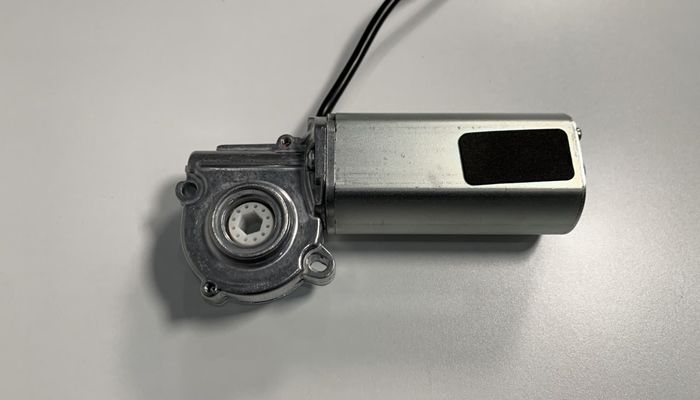
Unlike the standard Uplift v2, the Commercial v2 utilizes the improved JieCang motor found on the Jarvis. Using a fully internalized worm drive and gear system, with the hall sensors also internalized, this is a definite upgrade for their motors.
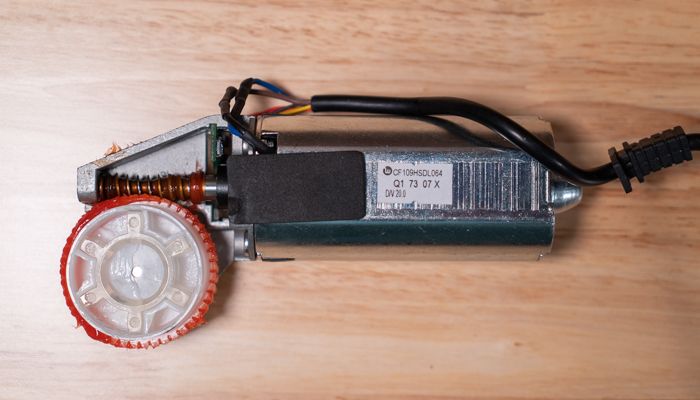
The VertDesk v3’s motor is built by Ketterer, a leading German gear and motor manufacturer. Founded in the early 1800’s as a clock manufacturer (specialty gears), in the 1970’s they evolved, creating a gear and motor division for vertical adjustment. The motor on the VertDesk v3 is well put together. All components, including the worm drive and gear system, are fully sealed within a custom encasement. The gear system utilizes two bearings to improve efficiency.
Gear Comparisons
The gears on a standing desk are a key component to how smooth and efficient a desk will operate over its lifetime. Low-quality gears can create a list of problems, from lower weight capacities to gear failures that ultimately stop a desk from functioning. Additional wear on a motor from inefficient gears can reduce a desks lifetime as it holds the potential to burn out lower quality motors on cheap standing desks.
The gear system found inside the Uplift v2 Commercial is the latest version we’ve seen coming from JieCang. It features an enclosed support tube, that houses the middle and lower section of the gear. This has created a cleaner look and is definitely an improvement over its previous versions of gears. Not as much of a surprise, but the gear system looks similar to that of the Linak gears we’ve tested, which is JieCangs favorite leader to copy from.
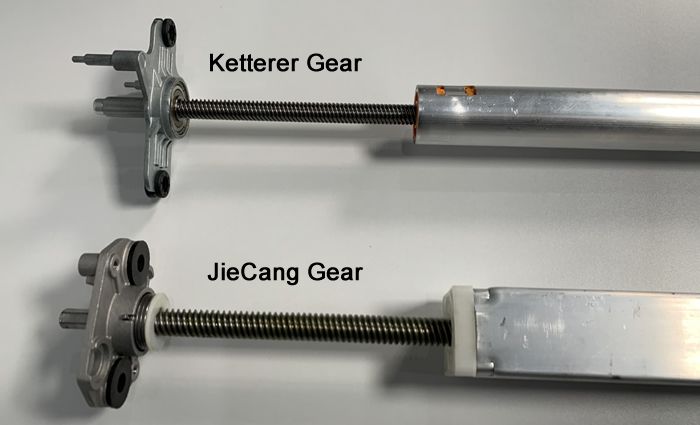
Unfortunately, like most that try to copy, you never really get the opportunity to lead and tend to be two steps behind. One of the most interesting things I learned about the design of all JieCang gears is that even with their most recent version of gear, they continue to use dated technology, more specifically the use of the spring system found just below the motor mounting plate.


These spring systems are generally used for the prevention of back driving, which is a natural result of gravity on the desk when it loses power. Manufacturers like Linak and Ketterer use precision engineering in their worm drive and gear to prevent this, with the assistance of electromagnetism from the coil and magnets inside the motor. By using the correct pitch of the worm and worm gear, you’re able to hold the desk in place when power is lost to the desk.
The design of the spring system on the Uplift v2 Commercial restricts the efficiency of the gear in both directions. Ultimately, this makes the motors on the desk work harder, regardless of the load placed on the desk.
The gears on the VertDesk v3 are the exact opposite, allowing you to easily pull them in and out when removed from the desk. The gear system on the VertDesk v3 is manufactured by Ketterer, the same German company producing the motor. With exceptional engineering and a high-quality control standard set by its organization, the gear systems work flawlessly. This precision allows the motors to run at max efficiency, ensuring the maximum lifespan can be expected of the single large motor.


Glide Comparisons
Having the proper fit glides can make or break your standing desk’s stability and efficiency. Glides are used for two reasons: To provide the proper fit between the inner and outer columns and to act as a lubricant. This allows the two pieces of metal to slide back and forth with ease. Having glides that do not correctly fit, in production, will create stability issues. While all glides will naturally wear down over time, better quality materials do hold up better over the high cycle counts most standing desks will experience. This is important because as a glide wears down, the stability of the desk will be impacted and how your desk functions today can be very different in as little as a year or two.
The Uplift v2 Commercial’s column design was different than the standard v2 we had recently reviewed. With the change, there was also a tweak to the internal glide system. The change made created a cleaner look on the outside of the column; hiding holes typically used to click the glides into place. It also meant they had to use a single collar type glide for their upper glide.
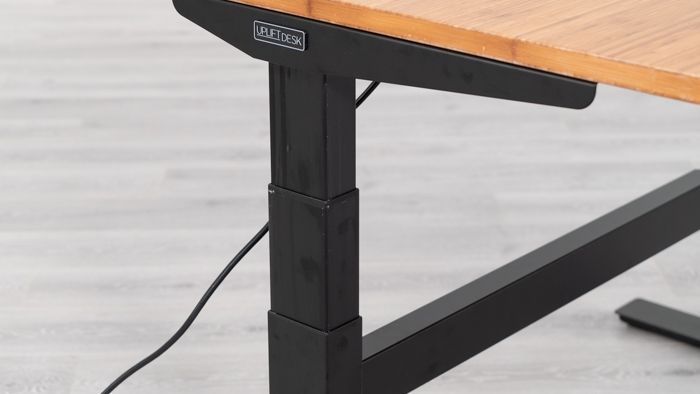
The remaining glides inside the v2 Commercial column were the same as what we’ve found on previous JieCang products. While the material types of the JieCang glides are unknown, we’ve found similar issues with the glides on other JieCang products tested. Their thin design, with a post system that holds the glide and gear system in place, are not durable enough, in my opinion. When you compare these to designs they are mimicking from Linak, there is a significant difference in the thickness of the two brand’s glides.
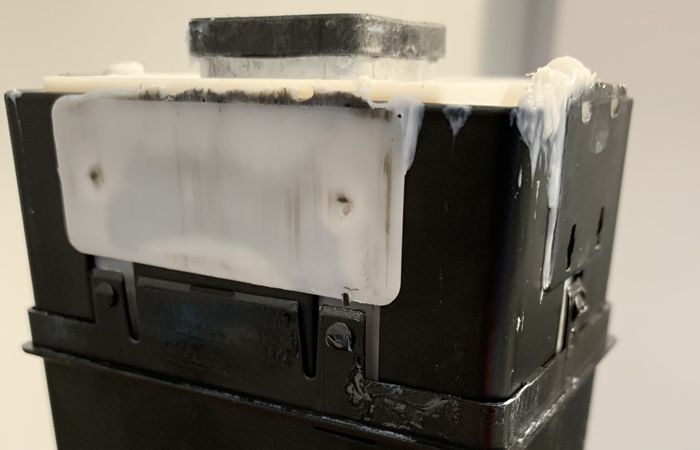
The glide system on the VertDesk v3 is made with highly durable acetal plastic from Dupont. This plastic is designed to provide good lubrication and hold up well to high count cycles. With multiple glide sizes, each column is custom fit together to ensure the best fit. There is a fine line between creating a column that it too tight, which can cause issues with electronics, or columns that are too loose.
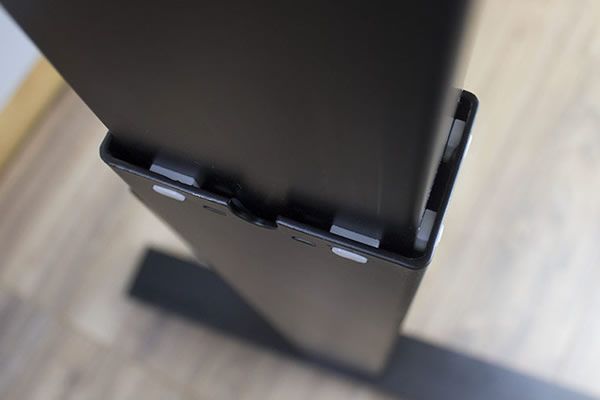
Where the two columns of the VertDesk are married together, plastic covers hide the natural gap between the two columns. While this does a good job creating a finished look, the Uplift Desks’ latest design is a cleaner overall look.
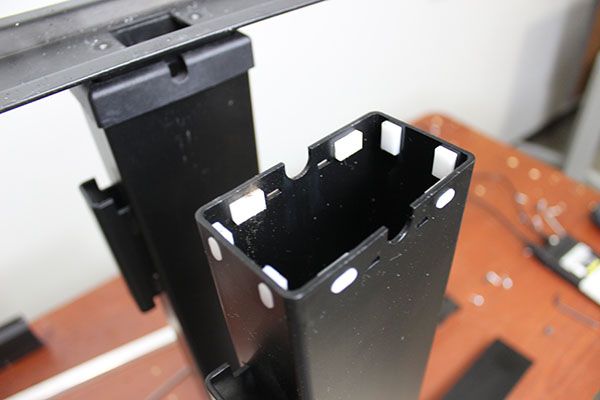
Frame and Foot Comparison
The foot and frame design of a standing desk are important, as they are the foundation of the desk. Getting this right plays a big part in how stable a standing desk will be. We’ve had feet on standing desks arrive to the lab that bend easily and ruin a desks stability at low to mid heights. The same is true for poorly designed frames. Both the Uplift v2 Commercial and VertDesk v3 did well here, with very stout frame designs.
One of the first things we noticed about the Uplift Commercial desk when it arrived was how heavy it was. The columns overall were larger than other desks we’ve tested from JieCang as well. The Uplift Commercial also utilized a traditional design, with the largest column on the bottom and the smallest on top. This allowed them to use a traditional cross support between the bottom column set.
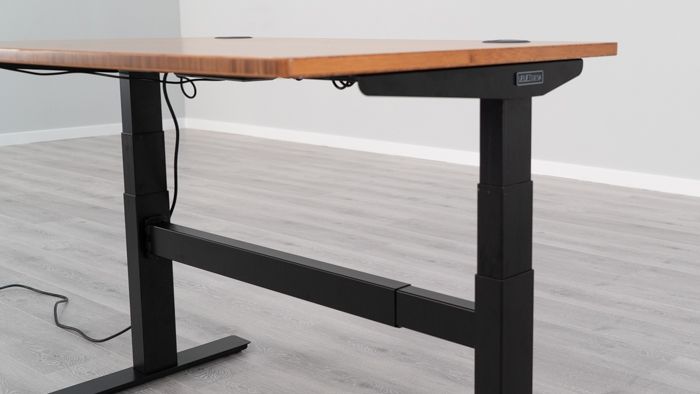
The v2 Commercial desk comes with a low profile steel foot design, which is likely done to allow it to get to its lowest height setting. The foot is formed from thick plate steel, which created a solid foot that didn’t show any flexing issues at mid to tall heights.
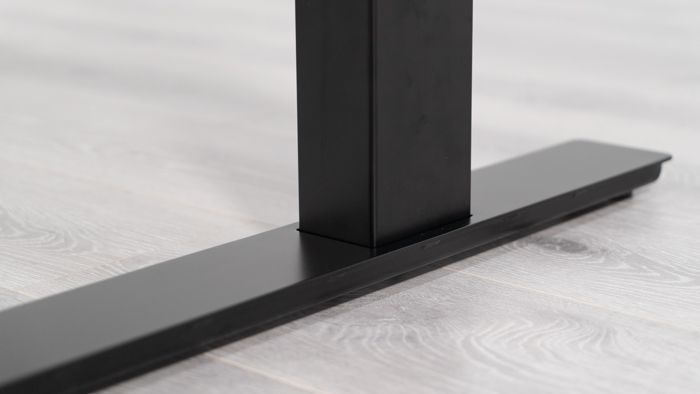
The expandable cross support on the v2 Commercial was a tank, just like the rest of the frame. Because of this, we didn’t really have any issues here with movement when built. My only recommendation would be to use some Loctite to hold the set screws in place as you use the desk.
The VertDesk v3 frame is also heavy, with thick steel tubing used for the uprights. The v2 Commercial tubes are slightly larger, but the VertDesk’s tubes are slightly thicker. The VertDesk v3 comes with the upper supports and feet welded to the columns. This creates a permanent connection that prevents any potential movement from bolt connections.
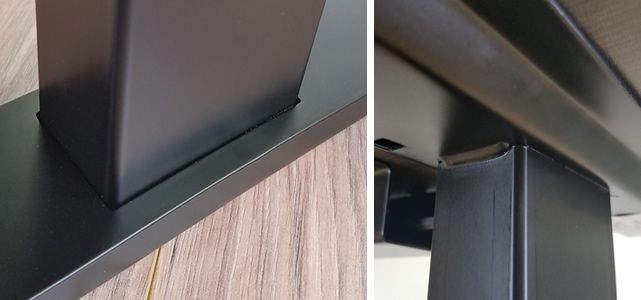
The foot design on the VertDesk is from formed steel, with tall enough side walls to maximize the strength of the foot. The design prevents any flexing that might occur when the desk is raised from mid to tall heights.

The VertDesk comes with a traditional cross support as well, which is a single formed steel design. This design was created so that there aren’t any issues from moving parts. While we didn’t have any problems noticeable from the Uplift v2 cross support, we’d prefer to avoid any weak points here with the single-piece design. Overall, both desks had nice consistent paint finished throughout the frame. The welds used to create the tubes were well done and not easily visible on either desk.
Frame Colors
The Uplift is available in black, silver white and a metallic industrial style frame finish.
The VertDesk v3 is currently available in black, silver and white.
Desk Top Options
If you decide to get the entire desk with top, the VertDesk v3 and Uplift are available in an assortment of top options.
The VertDesk v3 currently has a larger selection of commercial-grade laminate tops with twelve wood grain prints and solid color options available. There are 304 size options, with the ability to select any size from 23″ to 30″ deep and 36″ to 72″ wide, in full inch increments.
The Uplift Desk has a better selection of bamboo, hardwood, and reclaimed wood top options. It comes in nine different size options, with two overall depths of 24″ and 30″. It is available in 42″, 48″, 60″, 72″ and 80″ wide. The Uplift Desk is also available in similarly sized laminate options as their bamboo.
Optional Upgrades
| VertDesk v3 | Uplift v2 | |
| Programmable Button | $49 | $34 |
| Bluetooth Upgrade | $20 | $19 |
| Power Option | $39/each | $39 single / $69 pair |
| Locking Casters | $29/set | $29/set |
| Wire Management Kit | $68 with power strip | Up to $69 with power strip |
Return Policy
The Uplift v2 Commercial comes with a 30-day money-back guarantee. There are no restocking fees and no return shipping fees.
The VertDesk v3 comes with a 30-day money-back guarantee. There are no restocking fees and BTOD.com covers the return shipping costs.
Warranty
Like other Uplift Desk branded desks, the v2 Commercial comes with a solid warranty on the frame. Covering all components of the frame, including electronics, for a period of fifteen years.
The warranty coverage on the surfaces being sold by Uplift Desk is now covered for a period of fifteen years as well.
The VertDesk v3 comes with a lifetime warranty on the surfaces and entire frame, including electronics.
Bottom Line
Without question, two of the most stable standing desks we’ve tested, the Uplift Commercial and VertDesk v3, are great options for those looking to avoid annoying wobble and rocking motions. Which desk is best for you will depend on a host of different things.
The Uplift v2 Commercial has a nice range of motion for shorter users and includes a large lifting capacity as well. With a fifteen-year warranty on electronics, the lower quality components are at least covered by Uplift in case issues arise. The Uplift v2 Commercial is an upgrade to its standard Uplift v2, but comes with a 20% higher price tag.
The VertDesk v3 won’t offer the same adjustment range, but has a weight capacity that should be suitable for most user’s needs. The internal components of the VertDesk v3 are similar to what is found on premium brands like NewHeights and OMT Vehyl. This makes the VertDesk a good value in the mid-range. Both products could be a good fit, depending on your specific needs. Honestly, I have no problem recommending either option. I hope this comparison has helped make your decision easier. Happy standing!


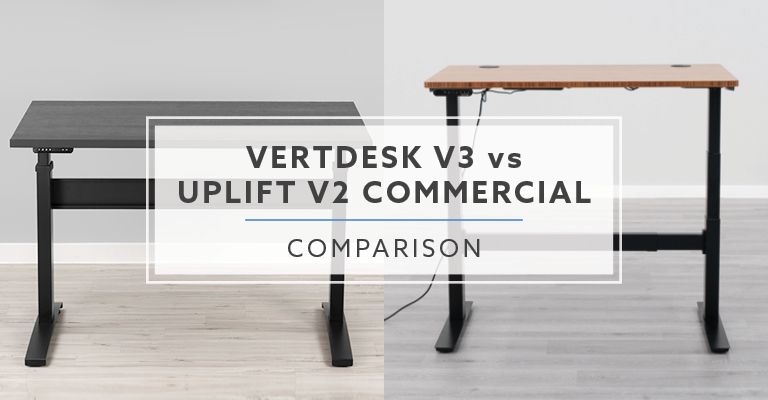



Richard
How do the L versions perform (Vert, NewHeights, Uplift v2)? Thank you.